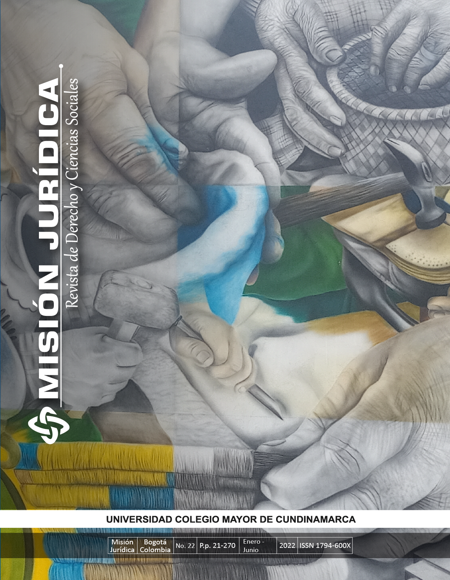Research in comparative law from the perspective of the rapid development of international trade between China and Spanish speaking countries
Investigación en derecho comparado desde la perspectiva del desarrollo rápido del comercio internacional entre China y los países hispanohablantes
COPYRIGHT PROVISIONS
Every papper included in the magazine can be reproduced whole or in part, provided that respect for its original content, the source is acknowledged and is used with non-commercial academic. Legal mission and its content is protected under a license Creative Commons Attribution-Noncommercial-

Misión Jurídica is distributed under a Creative Commons Attribution-NonCommercial-NoDerivar 4.0 International License.
Based on a work in http://unicolmayor.edu.co/publicaciones/index.php/mjuridica/index.
Permits that go beyond what is covered by this license can be found at http://unicolmayor.edu.co/publicaciones/index.php/mjuridica/index.
Show authors biography
In the latest 40 years the legal translation has played an increasingly important role in the field of international legal exchanges, as in the commercial trade, the comparative legal studies, etc., but when we exam the legal translation from a cultural perspective, it's obvious that the cultural factors have become the main obstacles in the process of legal translation. This study falls within the context of the socio-cognitive approach and the frame semantics. In this paper, we are trying to study the cultural factors that affect the complex process of legal communication, as well as the strategies to achieve the legal and cultural functionalities of the legal translation, so as to promote the development of legal translation.
Article visits 195 | PDF visits 123
Downloads
- Bächler S., R. C. (2014). El cognitivismo y la negación de la mente: influencia del dualismo cartesiano. Panorama 8(14), 47-58.
- Bello, A. (1855). Código Civil de la República de Chile. Traducido por Xu Diyu. (2014). Peking University Press.
- Chen, Z. (2010). La traducción al chino del Código Penal Federal de México. People's Public Security University of China Press.
- Chen, Z. (2015). La traducción al chino del Código Penal de Chile. People´s Public Security University of China Press.
- Comisión General de Codificación. (1885). Código Comercial de España. Traducido por Pan Deng y Gao Yuan. (2008). Editorial de la Universidad China de Ciencias Políticas y Derecho.
- Comisión General de Codificación. (1812-1978). La Constitución Española. Traducida por Pan Deng y Shan Yanfang. (2006). Editorial de la Universidad China de Ciencias Políticas y Derecho.
- Comisión General de Codificación. (1889). Código Civil de España. Traducido por Pan Deng y Ma Qin. (2013). Editorial de la Universidad China de Ciencias Políticas y Derecho.
- David, R. (1982). Les grands sistemas de droit contemporains. Dalloz. de Eizaguirre, J. M. (2012). Civil law: la vigencia de una categoría convencional. Anuario de Derecho Civil LXV (II), 535.
- Fillmore, C. J. (2003). Double-Decker definitions: The role of frames in meaning explanations. Sign Language Studies 3 (3), 263-295.
- Fillmore, C. J. (1985). Frames and the semantics of understanding. Quaderni di Semantica 6 (2), 222-253.
- Fillmore, C. J. (1982). Frame semantics. En Linguistics in the Morning Calm, (pp. 111-137). Linguistic Society of Korea (Edits.). Hanshin Publishing.
- García-Pelayo y Gross., R. (1974). Diccionario Larousse Usual. Editorial Larousse.
- Gardner, H. (1996). La nueva ciencia de la mente. Historia de la revolución cognitiva. Paidós.
- Garrido N., R. (1999). Traducción jurídica y derecho comparado. En Lengua y cultura: estudios en torno a la traducción. vol. II (pp. 423-428).VII Encuentros Complutenses en torno a la traducción M. Á. Vega C., y R Martín-Gaitero (Edits.). Universidad Complutense de Madrid, Instituto Universitario de Lenguas Modernas y Traductores. http://www.dialnet.unirioja.es.
- Instituto de comercio internacional y Cooperación Económica del Ministerio de comercio/ Oficina Económico-Comercial de la Embajada de la República Popular China en el Reino de España/ División de inversión exterior y Cooperación Económica del Ministerio de Comercio. Guía de cooperación e inversión en España https://www.yidaiyilu.gov.cn/wcm.files/upload/CMSydylgw/202002/202002140305019.pdf
- Lawrence M., F. (1969). Legal culture and social development. Law & Society Review 4 (1), 29-44.
- López M., R. del C. (2014-2015). Cultura jurídica. Eunomía. Revista en cultura de la legalidad (7), 230.
- Oficina económica y comercial de la Embajada de España acreditada en Pekín, China. http://www.spainbusiness.com.cn.
- Pan, D. (2004). La traducción al chino del Código Penal de España. Editorial de la Universidad China de Ciencias Políticas y Derecho.
- Pontrandolfo, G. (2013). Polisemia y sinonimia en la terminología del derecho procesal penal español e italiano: el caso de ‘sumario’/‘indagini preliminari’. Revista de llengua i dret 60, 46.
- Raymond T, Chu. (2002). Comments on the mistranslated terms in English for the legal profession: some basic rules of translation of legal terms of art. Chinese translators journal 23 (3), 65-70.
- Rocha H., L. (2005). Antropología y moral en René Descartes. [Tesis doctoral. Universidad Complutense de Madrid].
- Sarcevic, S. (1997). New Approach to legal translation. Kluwer Law International.
- Sun, Y. (1999). Nuevo diccionario chino-español. The Commercial Press. Universidad Zhongnan de Economía y Derecho. Facultad de Derecho. http://www.law.zuel.edu.cn.
- Vela, S. J. (2009). Reflexiones de un teólogo ‘pastoralista’ sobre la teología. Theologica Xaveriana 59 (167), 19-21.
- Xu, D. (2007). La traducción al chino del Código Civil de la República Argentina 1998. Law Press China.
- Xu, D. (2017). La traducción al chino del nuevo Código Civil de la República del Perú. Peking University Press.
- Yun, L. (2020). La suspensión del cumplimiento: comparación entre la excepción por inseguridad (o la excepción por incertidumbre), la exceptio non admipleti contractus y el incumplimiento anticipado. Revista Jurídica 39, 225-252.
- Zhang, L. (2009). Los últimos avances en la codificación del derecho civil chino. Revista chilena de derecho 36 (3), 468.
- Zhou, T. (2009). Investigación sobre la teología. Catholic church in China 2, p. 15-16.















